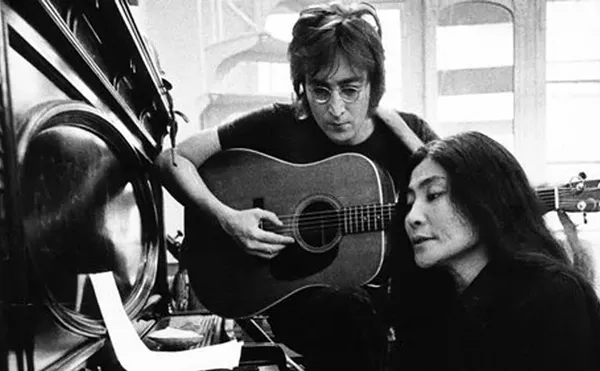Combining thoughtful criticism, news, analysis and "Page Six" style gossip, Tyler Green's blog Modern Art Notes (www.artsjournal.com/man) has been listed among "the most influential visual arts blogs" by The Wall Street Journal. Green's no-holds-barred approach has positioned him as the conscience of the art world, for more than six years, calling bluffs, breaking stories and cleverly sounding off on art, artists, art junkies and the organizations that institutionalize them. The influence of the Washington, D.C.-based blogger is huge: A New York Times art critic resigned from the board of a major cultural institution after Green put the spotlight on the conflict of interest. He also broke the story of the controversial resignation of the former head of the powerful Getty Trust in Los Angeles.
Green comes to Detroit this week to give a talk as part of College for Creative Studies' Woodward Lecture Series, which I direct. Metro Times asked me to chat with him via email about arts writing and the contemporary art world.
Metro Times:You're like the Bill Maher of the art world — unafraid to say what you think and to throw verbal punches when necessary. How would you characterize your blog persona?
Tyler Green: Oooh, I like that. On the blog I'm just like I am in person, only more handsome. I try to write about what I'm thinking about. It's not much more complicated than that.
MT: In reference to the World War II Memorial in Washington, D.C., you wrote: "The new monument feels as if a fascist architect had designed a food court for the Mall of America, and then accidentally shipped it to Washington." A commenter responded with "I hope you burn in hell, hippie."
Green: Here's what's hilarious — and I didn't know this before I wrote that line — the architect for the memorial actually had designed a shopping mall food court.
I don't get much hate mail. In fact, since National Magazine Award-winning critic-sock puppet Lee Siegel (he wrote for The New Republic and Slate) was disgraced into silence a while back (for commenting on his own stories and attacking commenters, all under a pseudonym) I've gotten absolutely none. Coincidence?
MT: You once said that you think one of the most masturbatory discussions in the art world is whether art criticism is dead. There's been endless dialogue about this — even here in Detroit.
Green: When people say art criticism is dead, what they mean is: "Why isn't anyone reading me?" Contemporary art now has an interest base all over the U.S., all over the world. So there are lots of potential readers out there. Media have changed. Critics and criticism have to too.
MT: Restaurant, book and film reviewers often offer serious critique, even occasionally trashing their subjects. Do you ever trash art?
Green: Yes, but probably not enough. You can't go there too much or you lose credibility. And if you hate everything you see it's time for a new line of work.
MT: What do you suppose is lacking in art criticism today?
Green: Guts! Stones! Cojones! Too many critics putz around so much that they never quite get to making a case for their reading or contextualization of art (aka opinions) or even to truth. I mean, who wants to read New York Times critic Michael Kimmelman "review" another show at the Met by writing a hagiography of a painter who has been dead for eighty yearzzzzzzz …
Christopher Knight of the L.A. Times has written that too many critics and their publications want to educate their readers. He's right. Education is for classrooms, not for critics.
MT: If not to educate, then what? What purpose should art criticism serve?
Green: To contextualize, to place within the narrative of art history, world history, current events, to choose and elevate (or not), all through the lens of the individual doing the commenting. That's probably the worst short definition ever.
MT: You recently wrote: "The trend toward featurization of art writing has … generated a rash of writers who unquestioningly fall hook-line-and-sinker for PR spin knowing that they'll stay on the right lists." What is the most important role of the arts critic today?
Green: A critic is able — in fact, privileged — to be above the fray in a way that dealers, curators, collectors and their related puppets aren't. It's imperative that they write from that position. If the critic can't ignore the scene to write about the work, who can? Unfortunately way, way, way too many people who write about art are concerned with being invited to the best parties and to the homes of private collectors. It shows in their writing.
Great example: Artforum is allegedly the art magazine of record. But recently when one of its writers, David Rimanelli, went to write about a show for them, he ended up visiting the house of the show's curator, trying on children's clothing in the curator's closet — and then he wrote about it!
MT: Who are some of your favorite writers working in the field today?
Green: Three-time Pulitzer Prize finalist Christopher Knight of the L.A. Times is at the top of the heap. More than anyone else in America he writes from a distinct, consistent, definable point of view. Then Roberta Smith (The New York Times) and her husband, two-time Pulitzer finalist Jerry Saltz. No two American critics better lift artists from obscurity to must-see status. And, in Roberta's case, she's the strongest New York voice on postwar art. I love Dave Hickey when he writes, and when he writes about art. The New Yorker's Peter Schjeldahl may have lost his fastball, but he's still great. In his prime he might have been the best writer in America period. Among those who blog, I start my day with Edward Winkleman. He's a dealer who blogs. If I were an art student or a young artist, I'd read him every day to understand how the beast works, how to be a pro.
MT: The Internet has made it possible for local critics — or just anybody, really — to become nationally known. Do blogs give voice to middle America? What does local mean anymore?
Green: It means that while New York still has the biggest megaphone, interesting writers from west of the Hudson have a much, much broader potential readership. And writers/critics who don't take advantage of that, who don't work to get read beyond 11 Avenue, are shooting themselves in their Pradas.
MT: There's a school of thought that traditional art journalists, those committed to publishing in mainstream vehicles (newspapers, periodicals, journals) are threatened by the popularity of art blogs as instruments for art criticism. What do you think about this?
Green: Well, I write for lots of dead-tree media, mostly for Fortune magazine these days. If you feel threatened, adapt. If you're a freelancer, change your income-generation model. Lots of good critics, such as Richard Lacayo at Time or Regina Hackett at the Seattle Post-Intelligencer blog now.
MT: The Wall Street Journal said "You won't find a better-informed art writer than Tyler Green." For an outsider, you sure seem to have an inside track to art world gossip. How do you coax information out of would-be sources?
Green: Well, I'm not sure I qualify as an outsider anymore I'm afraid. I just talk to lots of people. When people can't get the New York Times or their local newspaper to write about something it's easy to find me because my email address is published on MAN. What looks like sourcing is probably the product of a highly-public email address.
For a blogger especially, you are your own credibility. If people think I get it right most of the time even when they don't like what I wrote about them, they'll keep talking with me.
MT: But you started as an art world outsider, from the political field. What led you to make the transition from politics to art ?
Green: Long story. I started as a journalist, then quit that. The politics-to-art transition was accidental. I started the blog after 9/11 because, honestly, I needed something to do and I'd always loved art. And then after a time people started asking me to write for them. I re-discovered how much I enjoyed writing.
MT: Peter Schjeldahl once said that art is the sex life of money. We've been reading a lot about the art scene as opposed to art itself; what do you think about today's hype- and market-driven art world?
Green: I hate, hate, hate, hate the scene. I hate going to openings (so I don't), I hate going to soirees, I hate all of that stuff. What I love is looking at art. I love thinking about art, talking about art and writing about art. Look, the scene is there if you want to be seduced by it. But if you're a writer, a critic, I think you have a responsibility to yourself and to your readership to hold your ground, to be about the art.
MT: Detroit's art community is poised to be taken more seriously on the national front. We're trying endlessly to get on the national radar. What advice would you give us?
Green: If I were still a consultant I'd get paid $25,000 for answering this question. Darn! Before you do anything, make sure you have the attention of people in your own community: Artists, independent curators, writers and so on.
Then realize that the national radar is not the same as New York's radar. (The New York Times does not care about you and will not care about you. Neither will NYC-based magazines. And you know what? That's OK. That's even good. You are about Detroit and the communities near you; you are not about the Upper East Side).
Next, define what getting on the radar means to you. Does that mean attracting the attention of certain critics and writers? Does that mean tourism dollars? (This is very fashionable and very vapid.) Does that mean that your spaces, institutions attract interesting shows, curators and artists-in-residence? Does that mean that Detroit artists/curators/etc. have opportunities elsewhere?
I'll mention one thing I wish more places, be they Detroit, St. Louis, Indianapolis, Seattle or wherever, did: Museum types are always telling me that they want me to come see their place, their town, their show, their whatever. Great. When you do a modern or contemporary show or a collection re-installation invite me for a week-long, funded residency. Invite me to speak publicly, to meet with students, to see your museum, your commercial galleries, to shoot the breeze with your curators, and so on. Fund it. Invite curators, artists, and so on. Fund it. (And I don't mean me specifically, I mean people such as me.) Target young thinkers/artists-curators/etc. on the rise because if you get them at 30 you'll be informing what they do at 40. And fund it.
MT: One more thing: Are you ever confused for the Tyler Green who pitched for the Philadelphia Phillies in the '90s? You could sign a baseball and sell it on eBay if you were ever short on cash …
Green: My cousin played in the Phillies' minor league system with me. The other me. So, yes, even in my own family, I'm confused for myself. Or himself. Yeah, that.
Tyler Green lectures as part of College for Creative Studies' Woodward Lecture Series at 7:30 p.m., Thursday, Oct. 25, at the Anderson Auditorium, inside the Walter B. Ford Building on CCS' campus, Detroit; 313-664-7800.






